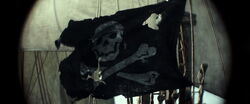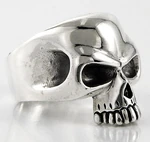| For other uses, see Skull (disambiguation) |

- "Say 'I do,' or I'll put a bullet in your skull."
- ―Pig Kelly
The skull is a bone structure that forms the head of most vertebrates. The skull forms the anterior-most portion of the skeleton and is a product of housing the brain, and several sensory structures such as the eyes, ears, nose, and mouth. In humans, these sensory structures are part of the facial skeleton. Like other vertebrates, the skull supports the structures of the face and protects the brain from injury. The English word skull is probably derived from Old Norse skulle, while the Latin word cranium comes from the Greek root κρανίον (kranion). The human skull fully develops two years after birth. The junctions of the skull bones are joined by structures called sutures.
History

A snake or skull represents the underworld and death.[1] The center of every piece of Aztec gold from the cursed treasure of Cortés featured an ominous skull.[2] Several magical objects in the Caribbean were skull-shaped, such as the Aztec Idol[3] and the Skull of Teoxuacata[4]
Bone piles made by the Pelegostos tribe were not just leftovers, for the tops of skulls made useful drinking cups.[5] When Jack Sparrow became their chief, he sat on a grand throne decorated with skulls and bones at the heart of the cannibal village.[6] The natives of Opawy Wato decorated their huts with skulls and bones.[7]

Every pirate captain flies his own variation of the Jolly Roger flag, the most famous of which is a trademark variation of the skull-and-crossbones theme.[8] Blackbeard's skull and flames revealed a passion for forbidden dark magic. Legends say that the Queen Anne's Revenge was built by Blackbeard's victims, but taking a closer look, it was actually constructed from them as well. Their skulls help to give the ship a tough outer shell.[9]
Behind the scenes
- Skulls are used throughout the Pirates of the Caribbean franchise. In the Pirates of the Caribbean attraction across Disney Parks and the 2012 attraction The Legend of Captain Jack Sparrow at Disney's Hollywood Studios, a talking skull (originally named as simply "Skull"[10]) issuing a series of ominous admonitions, specifically "Dead men tell no tales." All of the slightly various logos of the movie franchise feature a skull with either crossed swords, torches, or bones, similar to the Jolly Roger flag in the film's logos, posters, and various media.
- Real human remains were used in the Disneyland version of Pirates of the Caribbean attraction, most notably the skull and two crossed bones on the Pirate Captain's bed see in the "Captain's Quarter" scene of the ride.[11][12]
- Hector Barbossa was featured holding a skull in various promotional posters and wallpapers for Pirates of the Caribbean: The Curse of the Black Pearl and Dead Men Tell No Tales. This was visually similarly done with Blackbeard for On Stranger Tides, though the skull had a red bandana and trinkets similar to Jack Sparrow.
- When designing the Queen Anne's Revenge for On Stranger Tides, producer Jerry Bruckheimer said that since the most famous pirate flag is the skull and crossbones, skulls and skeletons should be worked into the actual design of the ship. This resulted in production designer John Myhre to recall Kostnice, the famous "Church of Bones" in Kutná Hora, Czech Republic. "It's this amazing church which is literally decorated with bones. They made garlands out of spines and pyramids out of skulls. And I thought wow, instead of doing all this intricately carved molding details, what if we just used the bones of Blackbeard's victims in the design of the 'Queen Anne's Revenge'? So we made moldings of leg and arm bones and teeth, and walls out of skulls, with the idea that Blackbeard actually burned his victims in a giant, flaming lantern on the stern of the ship."[13]

- The skull ring worn by Captain Teague in At World's End is Keith Richards' personal piece of jewelry.
- In real-world history, skull symbolism is the attachment of symbolic meaning to the human skull. The most common symbolic use of the skull is as a representation of death, mortality and the unachievable nature of immortality. Skulls were also associated with piracy due to its historical use in some Jolly Roger flags.
- In Pirates of the Caribbean Online the undead bosses are recognizable by the red skull over their heads.
- One cover of On Stranger Tides, the 1987 novel by Tim Powers, features a skull logo.
Appearances
- Walt Disney's Pirates of the Caribbean
- The Legend of Captain Jack Sparrow
- Jack Sparrow: The Coming Storm
- Jack Sparrow: The Pirate Chase
- Jack Sparrow: The Age of Bronze
- Pirates of the Caribbean: Armada of the Damned
- Legends of the Brethren Court: The Caribbean
- Tears of the Goddess
- Pirates of the Caribbean: The Curse of the Black Pearl
- Pirates of the Caribbean: The Legend of Jack Sparrow
- Legend of the Aztec Idol!
- The Dark Skull
- The Star of the Seas
- The Return of Jack Sparrow
- Pirates of the Caribbean Online
- Pirates of the Caribbean: Dead Man's Chest
- Pirates of the Caribbean: At World's End (video game)
- Pirates of the Caribbean: Tides of War
- Pirates of the Caribbean: On Stranger Tides
- LEGO Pirates of the Caribbean: The Video Game (Non-canonical appearance)
Sources
- The Pirates' Guidelines
- Pirates of the Caribbean: The Complete Visual Guide
- Pirates of the Caribbean: On Stranger Tides: The Visual Guide
- The Art of Pirates of the Caribbean: On Stranger Tides
External links
Notes and references
- ↑ The Pirates' Guidelines, p. 34
- ↑ Pirates of the Caribbean: The Complete Visual Guide, p. 22
- ↑ Legend of the Aztec Idol!
- ↑ Pirates of the Caribbean: The Legend of Jack Sparrow
- ↑ Pirates of the Caribbean: The Complete Visual Guide, pp. 52-53 "Cannibal Island"
- ↑ Pirates of the Caribbean: The Complete Visual Guide, pp. 54-55 "The Pelegostos Tribe"
- ↑ Pirates of the Caribbean: Armada of the Damned
- ↑ Pirates of the Caribbean: The Complete Visual Guide, pp. 30-31 "Life Below Deck"
- ↑ Pirates of the Caribbean: On Stranger Tides: The Visual Guide, pp. 30-31: "Queen Anne's Revenge"
- ↑ Attraction narration script, final draft 1967 featured in A Pirate's Life for Me: Disney’s Rascals, Scoundrels, Really Bad Eggs
- ↑ Hidden Gems: Real Bones on Pirates of the Caribbean
- ↑ Real Human Skull in Pirates of the Caribbean Disneyland
- ↑ Pirates of the Caribbean 4 production notes, pp. 22-23